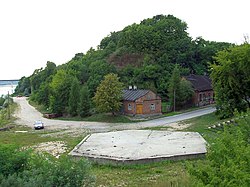Wyszogród: Difference between revisions
m WP:CHECKWIKI error fixes + general fixes using AWB (7922) |
SlavPoland (talk | contribs) |
||
| Line 59: | Line 59: | ||
*[http://www.wyszogrod.pl/ Official town webpage] |
*[http://www.wyszogrod.pl/ Official town webpage] |
||
*[http://www.jewishgen.org/yizkor/Wyszogrod/Wyszogrod.html Wyszogród at www.jewishgen.org] |
*[http://www.jewishgen.org/yizkor/Wyszogrod/Wyszogrod.html Wyszogród at www.jewishgen.org] |
||
* [http://www.sztetl.org.pl/en/city/wyszogrod/ Jewish Community in Wyszogród] on Virtual Shtetl |
|||
{{commons category|Wyszogród}} |
{{commons category|Wyszogród}} |
||
Revision as of 14:23, 24 March 2012
Wyszogród | |
|---|---|
 Castle hill | |
| Country | |
| Voivodeship | Masovian |
| County | Płock |
| Gmina | Wyszogród |
| Established | 1065 |
| Town rights | 1398 |
| Government | |
| • Mayor | Henryk Klusiewicz |
| Area | |
| • Total | 13.87 km2 (5.36 sq mi) |
| Population (2006) | |
| • Total | 2,772 |
| • Density | 200/km2 (520/sq mi) |
| Time zone | UTC+1 (CET) |
| • Summer (DST) | UTC+2 (CEST) |
| Postal code | 09-450 |
| Area code | +48 24 |
| Car plates | WPL |
| Website | http://www.wyszogrod.pl |
Wyszogród [vɨˈʂɔɡrut] is a town in Poland, in Masovian Voivodship, in Płock County, by the Vistula River. The population of Wyszogród was 2,793 in 2004.
History
The town of Wyszogród was an early Slavic settlement as early as 10th century. In 11th century it became fortified and started to act as a local centre of commerce. In 12th century it became the seat of local castellany and soon it became one of the seats of the Dukes of Masovia. Relocated on Magdeburg Law in 1398, Wyszogród became one of the most important inland ports and centres of textile production in the area.
During The Deluge the town was pillaged and burnt by the Swedes. Several subsequent fires destroyed Wyszogród almost completely. After the Partitions of Poland in 1793 annexed by Prussia. In 1807 reconquered by the Duchy of Warsaw and after the fall of Napoleon Bonaparte in 1815 transferred to the Kingdom of Poland. At the end of 19th century Wyszogród again recovered. During World War II, the town was heavily damaged in the course of the German Invasion of Poland in September, 1939. During the German occupation the Jewish population of the town perished in the Holocaust. There were several partisan groups operating both within the city and in the forests nearby. The town was rebuilt after the war, though its population did not recover to pre-war levels.
Attractions
- Church of the Holy Trinity (1773–1786)
- Remnants of the Franciscan abbey
- St. Mary of Angels Church (1408)
- Monastery (1684)
- Old Town market (18th and 19th centuries)
External links
- Official town webpage
- Wyszogród at www.jewishgen.org
- Jewish Community in Wyszogród on Virtual Shtetl
52°23′N 20°12′E / 52.383°N 20.200°E


